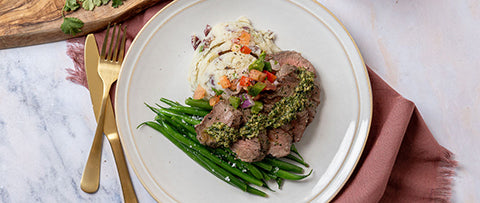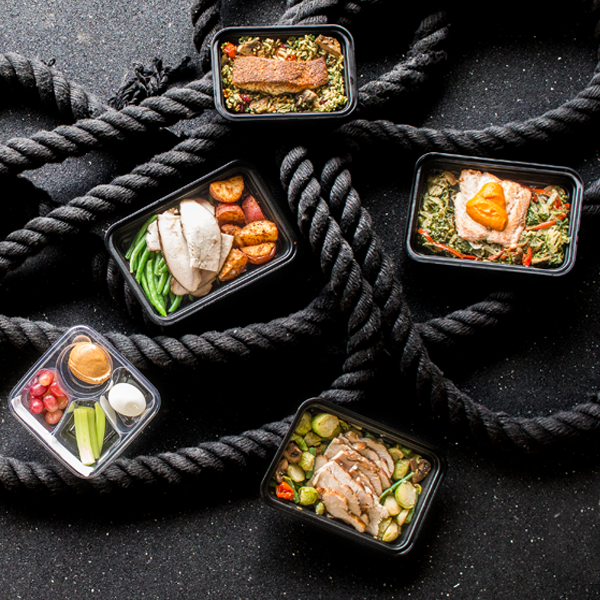In this article, I'll cover:
- What is Emotional Eating?
- Emotional eating vs. physical hunger
- Identifying emotional eating triggers
- Healthful ways to feed your feelings
What is Emotional Eating?
Have you ever felt down/stressed about a situation and found yourself turning to food… or even super excited and accomplished…and celebrated with food? If so, you have experienced emotional eating. This is extremely common and often is a large obstacle in implementing/maintaining a healthy lifestyle.
Take a second and think of a time when you ate as a response to feeling stressed, anxious, sad, happy, or excited. What was the situation that caused you to feel that way? What did you eat?
We all have an emotional relationship with food, therefore emotional eating is inevitable. Let’s define exactly what this term “emotional eating” means, which can also be known as stress eating.
Emotional Eating can be defined as:
- Using food to make yourself feel better.
- Eating to fill an emotional need rather than to fill your stomach in response to physical hunger/provide energy and nourishment to the body.
Now that we understand this definition, let’s differentiate between what is healthy and what is unhealthy.
Emotional eating can be healthy when the emotions driving the action are in celebration of an event or as a reward on occasion and the food is consumed in moderation. For example, having a piece of cake on your birthday (however having 5 pieces of cake would not be healthy).
Emotional eating is an unhealthy practice when food becomes your primary coping mechanism during an emotional bout. The problem lies when at the first sign of distress, your first impulse is to open the pantry or refrigerator and grab something to fill those immediate and intense feelings. You are not solving the real problem at hand. Emotional hunger cannot be filled with food.
During these episodes we often feel powerless. Remember, though, you are in control over what you put in your body and you can make a positive change.
Now that we understand the difference between positive and negative emotional eating, let’s explore the difference between emotional hunger and physical hunger.
Emotional Hunger vs. Physical Hunger
Emotional hunger can be very powerful and easily mistaken for physical hunger. Here are cues to help you tell them apart:
|
Emotional Hunger |
Physical Hunger |
|
Comes on suddenly. Hits you hard in an instant and feels overwhelming and urgent. |
Comes on more gradually (unless you haven’t eaten in a long time). |
|
Craves specific foods - typically highly processed junk foods. These foods provide an instant rush to the body. For example, you NEED pizza or cheesecake and NOTHING else will do. |
Almost anything sounds good —including very healthy foods such as vegetables and fruit. |
|
Often leads to mindless eating. Before you know it, you’ve eaten a whole bag of chips or an entire pint of ice cream without paying attention or truly enjoying what you have put in your mouth |
You are more aware of how you feel and what choices you are making about your food. This includes the types and portions of food you are choosing for nourishment. |
|
Does not satisfy you once you are physically full. As a result, you keep wanting more and more until you are uncomfortably stuffed. |
When your stomach is physically full, you feel satisfied and stop eating because you are nourished and satiated. |
|
Is not located in the stomach. Rather than a growling belly, emotional hunger is a craving you can’t get out of your head. |
You know you’re hungry when your stomach starts to growl. |
|
Leads to regret, guilt, and shame. Deep down, you’re not eating for nutrition reasons. |
Doesn’t make you feel guilty/ashamed because you are simply giving your body nourishment that it needs to survive. |
Identifying Emotional Eating Triggers
Once we understand the difference between emotional hunger and physical hunger, it is important to identify those situations, specific to each of us individually, which trigger our emotional eating episodes.
Ask yourself: What triggers do I have that cause me to eat when I'm not physically hungry?
Take a moment to reflect on what situations, places, or feelings make you reach for comfort food. What are your specific emotional triggers? By identifying them ahead of time, you can look out for them in the future. This practice prepares you to control any impulse to reach for food when you’re not really hungry.
Here are some common triggers of emotional eating:
- Stress – Ever notice you are super hungry when you’re stressed?
- The hormone cortisol triggers cravings for salty, sweet, and fried food.
- Higher stress = more likely you will turn to food for emotional relief
- Stuffing emotions – as a way to temporarily silence uncomfortable emotions (including: anger, fear, sadness, anxiety, loneliness, resentment and shame). This is a strategy to numb ourselves with food so we don’t have to face the emotions we’re feeling. Overcome this by addressing situations in all areas of your life that you may be avoiding due to discomfort.
- Boredom or feelings of emptiness – Do you ever simply give yourself something to do, to relieve boredom, or way to fill a void in life? Feeling unfulfilled and empty (in the moment), food is used as a way to fill your mouth and time and distract you from feeling bored or empty.
- Childhood habits – Think back to your childhood memories of food. Do you remember being rewarded with treats for good behavior (ex. Ice cream for good behavior or pizza for good grades)? This can carry over from childhood to adulthood. Sometimes habits are carried over for nostalgia.
- Social Influences – Getting together with friends and family is a great way to relieve stress, although, often leads to overeating. It’s easy to overindulge simply because everyone else is and food is there in front of you.
Healthful Ways to Feed Your Feelings
Often times emotions hijack our efforts to eat healthy and live a healthy lifestyle. In order to truly stop emotional eating, you have to find other ways to feed yourself emotionally. The first step, as we just discussed, is to understand the cycle of emotional eating and your unique triggers. Next, we need to find alternatives to your typical response to triggers for true emotional fulfillment, because food will not fill you up emotionally. Here are a few ways to replace food with a healthy outlet, depending on what you’re feeling:
- If you’re depressed – call someone who always makes you feel better. Play with a pet – like dog or cat. Look back at a photo from great memories and appreciate the positives in your life.
- If you’re anxious – Expend your nervous energy through movement, doing something physically active. Dance, squeeze a stress ball, do yoga, go for a run or brisk walk.
- If you’re exhausted – treat yourself to a hot cup of tea (at night choose decaf), take a hot bath, light some candles or incense, meditate, or wrap yourself up in a warm blanket.
- If you’re bored – Get up and move away from the kitchen. Go for a run or a hike. Read a book outside and enjoy the beautiful weather.
Overall, no matter what emotion you’re experiencing, use mindful eating to press pause when cravings hit.
Mindful eating is a practice that develops your awareness of eating habits and allows you to pause between your triggers and actions.
In the past, you might have given into your cravings and felt like you didn’t have enough willpower. The truth is that you have more power over your cravings than you think. Here are a few tips on how to eat mindfully rather than emotionally:
- Take 5 minutes before you begin emotional eating. Emotional eating is automatic and mindless. This time gap will help you determine if the hunger you are feeling is emotional or physical. Emotional hunger will pass.
- Learn to accept your feelings – even the bad ones.
- While it may seem that the core problem is that you’re powerless over food, emotional eating actually stems from feeling powerless over your emotions. You don’t feel capable of dealing with your feelings head on, so you avoid them with food.
- Allowing yourself to feel uncomfortable emotions can be scary. But the truth is that when we don’t obsess over or suppress our emotions, even the most painful and difficult feelings subside relatively quickly and lose their power to control our attention. To do this you need to become mindful and learn how to stay connected to your moment-to-moment emotional experience. This can enable you to rein in stress and repair emotional problems that often trigger emotional eating.
- Keep a food diary or journal. Track what you eat, how much, the times of day, and how you feel each time you eat. This may sound tedious, but it can help in identifying your emotional eating patterns. For example, you may discover that you reach for food primarily at the end of the work day, when you’re feeling stressed. By identifying those situations, you can prepare yourself to avoid reaching for food during those times.
- Seek professional help. Sometimes you need the help of a professional to talk through your emotions and keep you accountable in order to live a healthy lifestyle. Learning to eat mindfully takes time as you work to reverse emotional eating habits, and this process can feel overwhelming on your own.
(Feel free to reach out to me if you have any questions about nutrition counseling to overcome emotional eating and develop habits for mindful eating.)
The 8 steps in mindful eating
- Begin with your shopping list – Don’t put anything in your cart that you would feel guilty eating at home. Don’t even give yourself the opportunity to feel guilty.
- Come to the table hungry, not starving — Don’t skip meals, it leads to binge eating later in the evening until you fall asleep. Stick to an eating schedule and try to eat at the same times everyday. This way you’ll know that if you’re feeling hungry between your usual meal times you may be experiencing emotional hunger.
- Begin with small portions – Use a small plate if this helps.
- Appreciate your food – truly take a look at each and every thing on your plate. Enjoy each bite for what it is.
- Bring all your senses to the meal – Not only taste your meal but smell it, look at it, etc. As you chew, try to identify all the ingredients in the meal, including seasonings.
- Take small bites – Don’t inhale your food the second you get it. Before you know it, you will look down and nothing will be there. Enjoy your food. You will taste the food better when you take more, smaller bites.
- Chew thoroughly – Take the time to chew your food. Taste it and swallow it. (You may have to chew each mouthful 20 to 40 times, depending on the food.) You may be surprised at all the flavors that are released!
- Eat slowly – If you do the above, you won’t be able to eat your food super fast. Spend at the very least 20 minutes eating everything on your plate.
In conclusion, we’ve covered the differences between what it feels like to be emotionally hungry and physically hungry, your own triggers that cause you to turn to food when you are emotional (so that you can anticipate them before they occur), other ways to feed your feelings that work for you, and how to stay mindful by paying attention to everything you eat. I hope you feel equipped the next time you’re feeling overwhelmed and think about reaching for food!
If you have any questions about emotional eating, or anything related to nutrition for that matter, please don’t hesitate to reach out! You can email me at allison@fit-flavors.com





